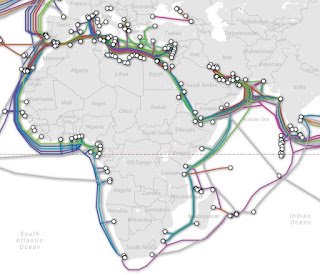To a lot of people, what we call the internet today is a virtual world that exists only in a land faraway. To them, the internet is a place, possibly in America, where accurate information can be accessed. Do you blame them? I don’t. We were taught that the internet was founded in America by the department of defense and that it was called the ARPANET. What we were not told, is that every device connected to the internet, becomes a part of the internet, with the ability to put anything (whether correct or misleading) on the net. We will look at the submarine cables that connect Nigeria over the Atlantic Ocean to the Internet.
In this article, I want to share with us how Nigeria is connected and remains a part of the internet. The great philosopher, Socrates, said that “The unexamined life is not worth living.” Since the internet is now a part of our lives, it is important that we examine it to see how we became a part of this global community. This article will help network engineers/administrators in deciding what ISP to subscribe to. For example, you need to have a dual connection for redundancy purpose. How do you make sure that you are not subscribing to two ISPs who are both connected to the same upper provider? This article will provide you with the information needed to make such critical decision.
As at today, Nigeria has a total of six submarine cables that connects her to the rest of the world. Each cable spans various distance, carrying huge amount of data traffics from Nigeria to the world. These submarine cables are subscribed to by various internet service providers in Nigeria who in turn sell their bandwidth to end users like you who use smartphones and computers to access the internet. Your data traffics go through your ISP network, through these cables to the rest of the world. They are:
>>Africa Coast to Europe (ACE)
>>Glo-1
>>Main-One
>>Nigeria Cameroon Submarine Cable System (NCSCS)
>>SAT-3/WASC
>>West African Cable System
Let’s look at them one after the other:
Africa Coast to Europe (ACE): One of the most advanced submarine cables to connect Nigeria to the internet. The cable is owned by a consortium of 19 operators and administrator headed by Orange telecoms. The first phase of the 17,000Km fibre optic cable was commissioned on the 15th of December, 2012. It connects Nigeria and the following countries to the internet: Côte d’Ivoire, Ghana), Gambia), Equatorial Guinea, South Africa, Portugal, Guinea, Benin, Senegal, Sierra Leone, Nigeria, Gabon, Angola, Liberia, Congo DR, Mauritania, France, Sao Tome and Principe, Namibia, Canary Islands, Spain.
The ACE submarine cable has an overall potential of 5.12 Terabits/s and MTN is one of its owners. Its landing point in Nigeria is Lagos.
Glo-1: The Glo-1 submarine cable is owned by Globalcom, an indigenous technology company. It’s a 9,800Km submarine cable that runs between Nigeria and the UK. It was commissioned in 2011 with a present total bandwidth capacity of 2.5 Terabits/s. The Glo-1 cable has presence in the following countries: Nigeria, Ghana, Senegal, Mauritania, Morocco, Portugal, Spain, and the UK. It carries data traffics for Glo and other ISPs like Coollink, Internet Solutions Nigeria, Phase3 telecoms, Cobranet Nigeria, Zeta Web, etc.
Main-One: Main-One is another indigenous cable provider in Nigeria. It is owned by Main Street Technology, a technology company headquartered in Lagos, Nigeria. The cable stretches across a 14,000Km distance, between Portugal and South Africa with landing points in Lagos and other African countries. It was commissioned in July, 2010 with a total bandwidth capacity of 1.28 Terabits/s. The Main-One submarine cable carries traffics for Main-One, Phase3 Telecoms, Interswitch, VDT Telecoms, etc.
Nigeria Cameroon Submarine Cable System (NCSCS): The NCSCS is a 1,100Km submarine cable that runs between Nigeria and Cameroon. It was completed in December, 2015 with a total bandwidth capacity of 12.8 Terabits/s. From the day of its commission, an initial bandwidth utilization of 40Gbp/s was recorded on the link. The Cameroon Telecoms (Camtel) owned NCSCS connects Cameroon to the internet via Nigeria.
SAT-3/WACS: The SAT-3/WACS undersea cable, one of the longest submarine cables in the world, spanning across seventeen different countries, is owned by a consortium that includes Nigerian Telecommunications Limited. It connects multiple African countries, including Nigeria, to the internet. It’s a 14,350Km cable that stretches between South Africa and Portugal, with landing points in Nigeria, Ghana, Cote d’Ivoire, etc. It has a combined North and South capacity of 1.720 Terabits/s. Ntel is one of the ISPs in Nigeria presently subscribed to SAT-3.
West African Cable System (WACS):
The West African Cable System is unarguably the longest submarine cable to land in Nigeria. With a distance of 14,530Km, stretching across multiple African countries to Europe, WACS is owned by a consortium of over ten companies that includes MTN. It currently has a total bandwidth capacity of 14.5Tbits/s and carries traffics for MTN.
The West African Cable System is unarguably the longest submarine cable to land in Nigeria. With a distance of 14,530Km, stretching across multiple African countries to Europe, WACS is owned by a consortium of over ten companies that includes MTN. It currently has a total bandwidth capacity of 14.5Tbits/s and carries traffics for MTN.
Every one of the multiple internet service providers in Nigeria, make use of one, two or three of these cables to transmit and receive data traffics across the internet. Any computer, phone, or any device connect to any of these cables through any ISP, becomes a part of the internet. The internet is everywhere and Nigeria is a part of it.

